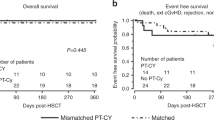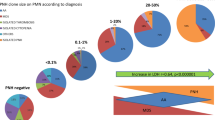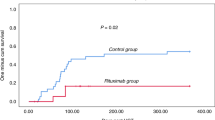Abstract
Paroxysmal nocturnal hemoglobinuria (PNH) is an acquired clonal disease of hematopoiesis due to a mutation in the PIG-A gene. Affected patients may demonstrate hemolysis or venous thrombosis, and may develop MDS or aplastic anemia. Successful results may be obtained after conditioning and transplantation from syngeneic or genotypically matched sibling donors. Experience with transplantation from matched unrelated donors (MUD) is limited to eight patients, with only one survivor. We report three patients who underwent successful MUD BMT for PNH. All three patients had severe aplastic anemia (SAA) and PNH at the time of BMT. Unrelated donors were six-antigen HLA-matched (n = 2) or HLA-A mismatched (n = 1). Conditioning consisted of cytarabine, cyclophosphamide, TBI, and ATG. Grafts were T cell-depleted by anti-CD6/CD8 antibodies + complement. Further GVHD prophylaxis consisted of cyclosporine. Patients received 0.7–1.1 × 108 nucleated cells/kg and 1.1–2.1 × 106 CD34+ cells/kg. Neutrophil engraftment occurred at 16–21 days. One patient developed grade 1 acute GVHD. Although all three patients experienced significant transplant-related complications, they ultimately resolved and all patients are alive and well 30–62 months after BMT. T cell-depleted MUD BMT is an effective treatment option for PNH-related MDS and SAA. Bone Marrow Transplantation (2001) 27, 589–592.
This is a preview of subscription content, access via your institution
Access options
Subscribe to this journal
Receive 12 print issues and online access
$259.00 per year
only $21.58 per issue
Buy this article
- Purchase on Springer Link
- Instant access to full article PDF
Prices may be subject to local taxes which are calculated during checkout
Similar content being viewed by others
References
Kinoshita T, Inoue N, Takeda J . Role of phosphatidylinositol-linked proteins in paroxysmal nocturnal hemoglobinuria pathogenesis Ann Rev Med 1996 47: 1–10
Rosse WF, Ware RE . The molecular basis of paroxysmal nocturnal hemoglobinuria Blood 1995 86: 3277–3286
Araten DJ, Nafa K, Pakdeesuwan K, Luzzatto L . Clonal populations of hematopoietic cells with paroxysmal noctumal hemoglobinuria genotype and phenotype are present in normal individuals Proc Nat Acad Sci USA 1999 96: 5209–5214
Hakim F, Childs R, Balow J et al. Development of paroxysmal nocturnal hemoglobinuria after chemotherapy Blood 1996 88: 4725–4726
Harris JW, Koscick R, Lazarus HM et al. Leukemia arising out of paroxysmal nocturnal hemoglobinuria Leuk Lymphoma 1999 32: 401–426
Dunn DE, Tanawattanacharoen P, Boccuni P, et al. Paroxysmal nocturmal hemoglobinuria cells in patients with bone marrow failure syndromes Ann Intern Med 1999 131: 401–408
Bourantas K . High-dose recombinant human erythropoietin and low-dose corticosteriods for treatment of anemia in paroxysmal nocturnal hemoglobinuria Acta Haematol 1994 91: 62–65
Harrington WJS, Kolodny L, Horstman LL et al. Danazol for paroxysmal nocturnal haemoglobinuria Am J Hematol 1997 54: 149–154
Doukas MA, Fleming D, Jennings D . Identical twin marrow transplantation for venous thrombosis in paroxysmal nocturnal hemoglobinuria; long-term complete remission as assessed by flow cytometry Bone Marrow Transplant 1998 22: 717–721
Kolb HJ, Holler E, Bender-Gotze C et al. Myeloablative conditioning for marrow transplantation in myelodysplastic syndromes and paroxysmal nocturnal haemoglobinuria Bone Marrow Transplant 1989 4: 29–34
Champlin RE, Feig SA, Sparkes RS, Gale RP . Bone marrow transplantation from identical twins in the treatment of aplastic anemia: implication for the pathogenesis of the disease Br J Haematol 1984 56: 455–463
Kawahara K, Witherspoon RP, Storb R . Marrow transplantation for paroxysmal noctumal hemoglobinuria Am J Hematol 1992 39: 283–288
Bemba M, Guradiola P, Garderet LU et al. Bone marrow transplantation for paroxysmal nocturnal haemoglobinuria Br J Haematol 1999 105: 366–368
Saso R, Marsh J, Cevreska L et al. Bone marrow transplants for paroxysmal nocturnal haemoglobinuria Br J Haematol 1999 104: 392–396
Graham ML, Rosse WF, Halperin EC et al. Resolution of Budd–Chiari syndrome following bone marrow transplantation for paroxysmal nocturnal haemoglobinuria Br J Haematol 1996 92: 707–710
Endo M, Beatty PG, Vreeke TM et al. Syngeneic bone marrow transplantation without conditioning in a patient with paroxysmal nocturmal hemoglobinuria: in vivo evidence that the mutant stem cells have a survival advantage Blood 1996 88: 742–750
Hershko C, Ho WG, Gale RP, Cline MJ . Cure of aplastic anemia in paroxysmal nocturnal hemoglobinuria by marrow transfusion from identical twin: failure of peripheral-leucocyte transfusion to correct marrow aplasia Lancet 1979 1: 945–947
Raiola AM, Van Lint MT, Lamparelli T et al. Bone marrow transplantation for paroxysmal nocturnal hemoglobinuria Haematologica 2000 85: 59–63
Bennett JM, Catovsky D . Proposals for the classification of the myelodysplastic syndromes Br J Haematol 1982 51: 189–199
Bearman SI, Appelbaum FR, Buckner CD et al. Regimen-related toxicity in patients undergoing bone marrow transplantation J Clin Oncol 1998 6: 1562–1568
Hongeng S, Krance RA, Bowman LA et al. Outcomes of transplantation with matched-sibling and unrelated-donor bone marrow in children with leukemia Lancet 1997 350: 767–771
Rooney CM, Smith CA, Ng CYC et al. Infusion of cytotoxic T cells for the prevention and treatment of Epstein–Barr virus-induced lymphoma in allogeneic transplant recipients Blood 1998 92: 1549–1555
Davies SM, Wagner JE, Defor T et al. Unrelated donor bone marrow transplantation for children and adolescents withaplastic anemia or myelodysplasia Br J Haematol 1997 96: 749–756
Tzeng CH, Chen PM, Fan et al. CY/TBI-800 as a pretransplant regimen for allogeneic bone marrow transplantation for severe aplastic anemia using HLA-haploidentical family donors Bone Marrow Transplant 1996 18: 273–277
Author information
Authors and Affiliations
Rights and permissions
About this article
Cite this article
Woodard, P., Wang, W., Pitts, N. et al. Successful unrelated donor bone marrow transplantation for paroxysmal nocturnal hemoglobinuria. Bone Marrow Transplant 27, 589–592 (2001). https://doi.org/10.1038/sj.bmt.1702827
Received:
Accepted:
Published:
Issue Date:
DOI: https://doi.org/10.1038/sj.bmt.1702827
Keywords
This article is cited by
-
Paroxysmal Nocturnal Hemoglobinuria: From Bench to Bed
Indian Journal of Hematology and Blood Transfusion (2016)
-
Unrelated donor bone marrow transplantation with treosulfan-based myeloablative conditioning for paroxysmal nocturnal hemoglobinuria- successful treatment despite multiple transplant-related risk factors for hemolysis including major Kidd group incompatibility
Bone Marrow Transplantation (2006)



